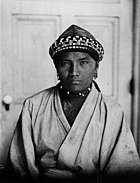 Global Information
Global InformationTaiwanese indigenous peoples information
 Paiwan and Rukai people in Pingtung County | |
| Total population | |
|---|---|
| ~569,000 or 2.50% of the population of Taiwan (Non-status and unrecognized indigenous peoples excluded) | |
| Regions with significant populations | |
| Taiwan and Orchid Island | |
| Languages | |
| Formosan languages (Atayal, Bunun, Amis, Paiwan, others) or Yami language Chinese languages (Mandarin, Hokkien, Hakka) | |
| Religion | |
| Majority Christianity, minority Animism[1] | |
| Related ethnic groups | |
| Taiwanese people, other Austronesians |
| Taiwanese indigenous peoples | |||||||||||||||||||||||||||
|---|---|---|---|---|---|---|---|---|---|---|---|---|---|---|---|---|---|---|---|---|---|---|---|---|---|---|---|
| Traditional Chinese | 臺灣原住民 | ||||||||||||||||||||||||||
| Simplified Chinese | 台湾原住民 | ||||||||||||||||||||||||||
| Literal meaning | Taiwanese original inhabitants | ||||||||||||||||||||||||||
| |||||||||||||||||||||||||||
| Taiwanese indigenous peoples |
|---|
 |
| Peoples |
|
Nationally Recognized
Locally recognized
Unrecognized
|
| Related topics |
|
Taiwanese indigenous peoples, also known as Formosans, Native Taiwanese or Austronesian Taiwanese[2][3] and formerly as Taiwanese aborigines, Takasago people or Gaoshan people,[4] are the indigenous peoples of Taiwan, with the nationally recognized subgroups numbering about 569,000 or 2.38% of the island's population. This total is increased to more than 800,000 if the indigenous peoples of the plains in Taiwan are included, pending future official recognition. When including those of mixed ancestry, such a number is possibly more than a million. Academic research suggests that their ancestors have been living on Taiwan for approximately 15,000 years. A wide body of evidence suggests that the Taiwanese indigenous peoples had maintained regular trade networks with numerous regional cultures of Southeast Asia before the Han Chinese colonists began settling on the island from the 17th century, at the behest of the Dutch colonial administration and later by successive governments towards the 20th century.[5][6]
Taiwanese indigenous peoples are Austronesians, with linguistic, genetic and cultural ties to other Austronesian peoples.[7] Taiwan is the origin and linguistic homeland of the oceanic Austronesian expansion, whose descendant groups today include the majority of the ethnic groups throughout many parts of East and Southeast Asia as well as Oceania and even Africa which includes Brunei, East Timor, Indonesia, Malaysia, Madagascar, Philippines, Micronesia, Island Melanesia and Polynesia. The Chams and Utsul of contemporary central and southern Vietnam and Hainan respectively are also a part of the Austronesian family.
For centuries, Taiwan's indigenous inhabitants experienced economic competition and military conflict with a series of colonizing newcomers. Centralized government policies designed to foster language shift and cultural assimilation, as well as continued contact with the colonizers through trade, inter-marriage and other intercultural processes, have resulted in varying degrees of language death and loss of original cultural identity. For example, of the approximately 26 known languages of the Taiwanese indigenous peoples – collectively referred to as the Formosan languages – at least ten are now extinct, five are moribund[8] and several are to some degree endangered. These languages are of unique historical significance since most historical linguists consider Taiwan to be the original homeland of the Austronesian language family.[5]
Due to discrimination or repression throughout the centuries, the indigenous peoples of Taiwan have experienced economic and social inequality, including a high unemployment rate and substandard education. Some indigenous groups today continue to be unrecognized by the government. Since the early 1980s, many indigenous groups have been actively seeking a higher degree of political self-determination and economic development.[9] The revival of ethnic pride is expressed in many ways by the indigenous peoples, including the incorporation of elements of their culture into cultural commodities such as cultural tourism, pop music and sports. Taiwan's Austronesian speakers were formerly distributed over much of the Taiwan archipelago, including the Central Mountain Range villages along the alluvial plains, as well as Orchid Island, Green Island, and Liuqiu Island.
The bulk of contemporary Taiwanese indigenous peoples mostly reside both in their traditional mountain villages as well as increasingly in Taiwan's urban areas. There are also the plains indigenous peoples, which have always lived in the lowland areas of the island. Ever since the end of the White Terror, some efforts have been under way in indigenous communities to revive traditional cultural practices and preserve their distinct traditional languages on the now Han Chinese majority island and for the latter to better understand more about them.[10] The Austronesian Cultural Festival in Taitung City is one means by which community members promote indigenous culture. In addition, several indigenous communities have become extensively involved in the tourism and ecotourism industries with the goal of achieving increased economic self-reliance and maintaining cultural integration.[11]
- ^ Stainton (2002).
- ^ Rigger, Shelley (2013). Why Taiwan Matters: Small Island, Global Powerhouse. Rowman & Littlefield. ISBN 978-1-4422-3002-6.
- ^ "One Island, Twenty Tongues". Ketagalan Media. 3 May 2017. Archived from the original on 4 May 2017. Retrieved 6 May 2017.
- ^ Hattaway (2003), pp. 39, 93, 425.
- ^ a b Blust (1999).
- ^ Hung, Hsiao-Chun; Iizuka, Yoshiyuki; Bellwood, Peter; Nguyen, Kim Dung; Bellina, Bérénice; Silapanth, Praon; Dizon, Eusebio; Santiago, Rey; Datan, Ipoi; Manton, Jonathan H. (2007). "Ancient jades map 3,000 years of prehistoric exchange in Southeast Asia". Proceedings of the National Academy of Sciences. 104 (50): 19745–19750. doi:10.1073/pnas.0707304104. PMC 2148369. PMID 18048347.
- ^ Trejaut, Jean A.; Poloni, Estella S.; Yen, Ju-Chen; Lai, Ying-Hui; Loo, Jun-Hun; Lee, Chien-Liang; He, Chun-Lin; Lin, Marie (1 January 2014). "Taiwan Y-chromosomal DNA variation and its relationship with Island Southeast Asia". BMC Genetics. 15: 77. doi:10.1186/1471-2156-15-77. ISSN 1471-2156. PMC 4083334. PMID 24965575.
- ^ Zeitoun & Yu (2005), p. 167.
- ^ Hsu (1991), pp. 95–9.
- ^ Kuo, Lily; Chen, Alicia (4 April 2022). "Taiwan's Han Chinese seek a new identity among the island's tribes". Washington Post. Retrieved 24 April 2022. Republished as: Kuo, Lily; Chen, Alicia (9 April 2022). "'Indigenous in spirit, even if not by blood': Han Chinese seek a new identity among Taiwan's tribes". The Independent. Retrieved 24 April 2022.
- ^ Anderson (2000), pp. 283–90.